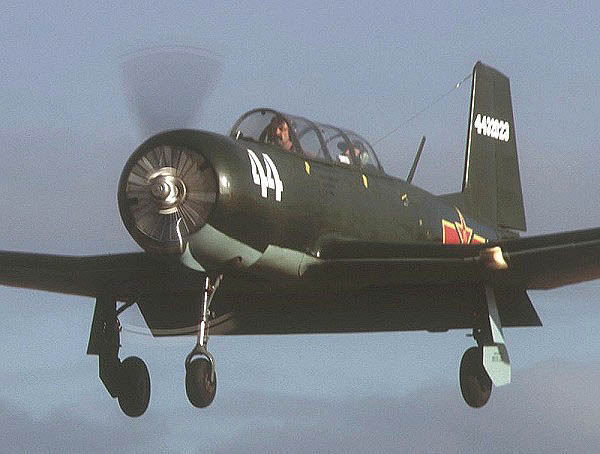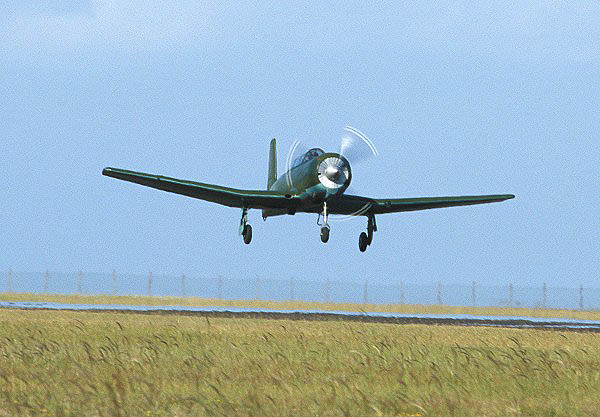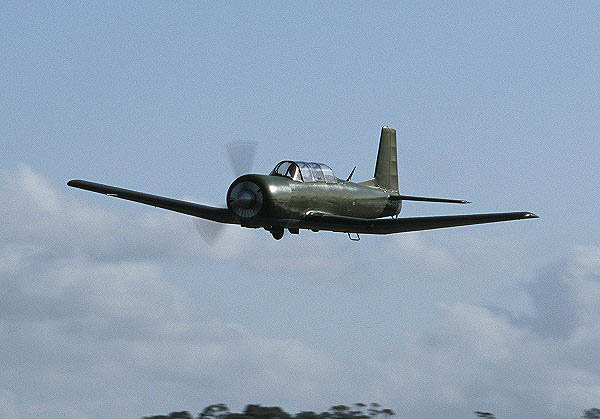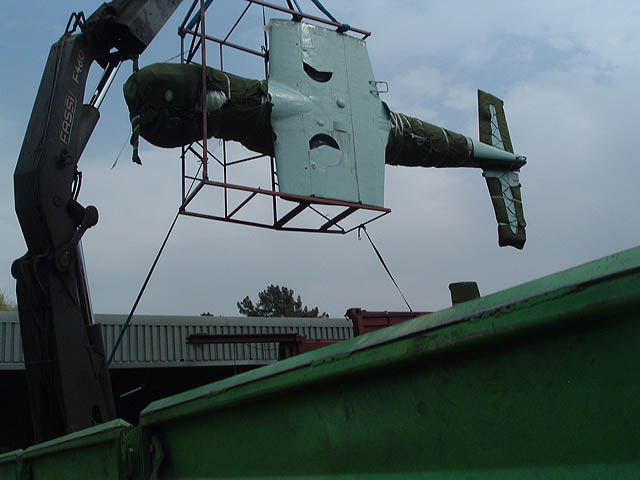|
NANCHANG CJ-6A Dragon AN AFFORDABLE WARBIRD
By Richard Broome and Graeme
Camage I’m standing next to a radial powered two seater tricycle undercarriage aircraft in Canberra, Australia’s capital. My host, Graeme Camage tells me this is a Chinese Air Force Nanchang CJ-6A trainer aircraft, the PLAAF’s basic and intermediate trainer. Students start here and then move into the Shenyang JJ-5 (MiG 15 equivalent) for their advanced training. A closer inspection convinces me that here is an aircraft that could be an ideal introductory warbird in South Africa. TheDragon has tandem seating and a radial engine. It appears to be a well-built and robust aircraft, and would obviously be more affordable to acquire and operate than, say, a Harvard. More importantly, it has a tricycle undercarriage, which would make it attractive to a wider audience of potential warbird owners. As a result my 40 year love affair with Harvards starts to fade and I commence the long process of convincing my wife to let me buy a couple of used Nanchang CJ-6A Dragon aircraft.
THE FIRST CJ-6As IN THE SOUTHERN HEMISPHERE
The first three
aircraft arrived safely in Sydney early June 1990. Placing the aircraft
on the Australian Civil register proved to be a relatively trouble free
process as the aircraft were in very good mechanical condition. The
Chinese had supplied all the logbooks and data that the Australian CAA
required to effect registration. Local test pilot Bruce Simpson
pronounced the Nanchang to be well balanced, stable, and performing “as
advertised”. His test flight turned out to be the first flight of a
Nanchang CJ-6 in private hands in the Southern hemisphere. Placing them
on the SA Civil Register was another story entirely. It was, to say the
least, a horrifying experience of bureacracy misunderstood, until a
change of CEO. However all this is history and the aircraft now fly in
SA on an NTCA full authority to fly.
OPERATING
THE CJ-6A DRAGON The Dragon is a dream to fly. It is initially, however, a dog to taxi. Like the Vampire it is steered by a combination of a joystick mounted brake handle and the rudder. Consequently, some thought is required in learning the technique of applying just the right amount of brake and rudder into turns. Newcomers to the type found they could easily get the aircraft into a tight turn in a confined space necessitating shutting the engine down, getting out, and straightening the nose wheel by hand. This gave rise to our statement “if you can taxi it to the holding point, you can fly it.” The Dagon is all air operated, using compressed air for engine starting, gear retraction, flap and brakes. Air is held at 750 psi in a main air bottle, which is replenished from an engine driven compressor. An emergency air back-up reservoir allows the undercarriage to be lowered in case of a failure of the main air supply in flight. The main air system allows for 4 to 5 starting attempts depending on how long the engine is cranked on each attempt. If the air is depleted, the system can be replenished from an external supply via a charging port in the side of the aircraft. And the engine can be started by the time honoured method of swinging the prop. Like the majority of military trainers, the Dragon has a limited range due to its fuel capacity of 177 litres, which is consumed at 50-55 lph. However, it gets along at a reasonable 135 kts at this fuel burn, which allows it to go a fair distance until the noise stops. Joburg-Durban is a snap with a reserve of over an hour. We flew ZU-EWF to Swakopmund and back with stops at Keetmanshoop, Upington and Kimberley. The low compression 285 HP engine was designed to operate on low (74) octane fuel and we believe it can operate happily on mogas. Graeme explained the more they flew the aircraft, the more they appreciated its many qualities. It has proven extremely reliable, relatively easy to maintain, and handles the many dirt and grass strips they have flown in and out of with ease. The Dragon has been flown by relatively low time GA pilots as well as Air Force veterans. No special licensing requirements are needed other than retractable undercarriage and constant speed prop endorsements. If you can legally fly a Piper Arrow, you can fly the Dragon. This aircraft is fully aerobatic, has excellent spinning characteristics and its power to weight ratio enables aerobatics to be conducted without losing height. When conducting aerobatics operations, we tend to keep all manoeuvres positive G as it has no inverted oil or fuel system and the engine will not run inverted. Cross-country we can carry two full size people, soft overnight baggage in a locker behind the rear seat and tie-down gear without overloading the aircraft. The rear seat is not a comfortable place to spend long periods in the middle of winter, but one can’t have everything. Creature comforts are not high on the priority list of the PLAAF in China. COULD THIS BE THE WARBIRD FOR ME? In SA very little is known about the Chinese aircraft industry let alone their military aircraft. The Chinese provide scant attention to the cosmetics of their aircraft. Paint and fit tends to be utilitarian with the emphasis on robustness and reliability rather than good looks. But the three new owners have been delighted with their purchases. The aircraft are now flown out of Brakpan by enthusiast Gordon Dyne, Heidelberg by Charlie Hughes and Swakopmund by Jacques Jacobs, who uses it to give adventure flights! Here is great youtube of aerobatics over the Namib. http://www.youtube.com/watch?v=QMyEtWIjH5Y Doubters are instantly transformed when they fly in the aircraft. Yes, while the Chinese are not greatly interested in how it looks, where it has to be good it is. All the aircraft skins are completely anodised so corrosion is an exception. Their welded and fabricated parts are works of high craftsmanship The trailing link undercarriage is almost indestructible. Here is an aircraft that can take whatever we can throw at it.
THE ENGINE The most common question from the would-be purchaser is “what about the engine?” OK we say, what about the engine? It’s a completely indigenous 9 cylinder 10 litre 285 HP radial built by Huosai in China. “Is it a copy of an American radial?” we are asked. Yes, probably, but after all, how much can one change the design of a radial engine? The fact is that this engine is well made, and made to last. It carries a 600-hour TBO in its military capacity where it is worked to the extremes in the training role. Here in SA, where the engine doesn’t have to work near as hard, we believe it will go a thousand hours, that is, another 400 hours “on condition” after its TBO has been reached. Graeme’s first Dragon was sold in to a New Zealander, Graeme Frew, in 1999 after its engine had done about 660 hours, that is, 60 hours past its TBO. Graeme had a good look at the aircraft, flew it around for a couple of months in Oz, put a ferry tank in the back cockpit and flew it home to Auckland over two days. The same engine is still running today in NZ and is approaching 1,000 hours. “And what about an engine overhaul?” we are asked. Why would you bother? We can land a zero time overhaul engine for not much more than US$20,000 complete with all accessories except exhausts, and the Chinese do not want the old engine back. Why would you overhaul an engine? Last time I looked I couldn’t get a Lycoming IO-360 engine overhauled for US$20,000. So as we see it, the engine for the Nanchang is not a major problem. IS IT A YAK? The CJ-6 is often called a Yak because of its similarity to the better-known Yak 52. Initially the aviation industry thought the CJ-6 was a derivative or licence built Yak 18A, but that assumption was incorrect. The CJ-6 is a totally indigenous Chinese aircraft having been designed and built from scratch by the Chinese aviation industry in the early 1960s. The similarity to the Yak probably comes from fact that until the introduction of the CJ-6 into the PLAAF they were operating the CJ-5, a licence built tail-dragging Yak 18. The PLAAF had intended to re-equip with the Yak 18A but considered its tube and fabric to be dated. So, they embarked on the design of the CJ-6. The construction of an all-metal monocoque airframe at the time was a great step forward, particularly for the fledgling Chinese aviation industry. The prototypes were built by Shenyang with 260 hp engines and Russian wooden propellers. Up to that time the Nanchang Company had been primarily engaged in the repair of aircraft. The manufacture of the production models of CJ-6 was its first step in manufacturing an entire aircraft. It was at Nanchang that the 285 hp engine and metal propeller were introduced, creating the CJ-6A. NAMC has since become a major player in the manufacture of military trainer and front line aircraft. YAK 52 vs NANCHANG CJ-6 The CJ-6’s “cousin”, the Yak 52, is a very similar aircraft in many ways and the close likeness has produced, in some cases, two different schools of people who claim one is better than the other. No different to the Ford and Holden fan clubs. In truth each aircraft has advantages and disadvantages over the other, for example: The CJ-6 has 285 HP versus the Yak’s 360 HP, yet they have very similar cruise and max speeds. The extra 75 HP appears to be used up overcoming the extra drag inherent in the Yak design, as the Yak’s wheels do not fully retract in flight, and to provide a better climb performance The CJ-6 holds more fuel and burns a little less, hence a longer range. The Yak is a better aerobatic mount as it is designed with more emphasis on its aerobatic role than the CJ-6. In addition, the Yak has an inverted fuel and oil system that allows inverted flight The CJ-6’s cranked wing and fully retracting main gear make it a better looking aircraft in the air Both aircraft use air systems for starting and other services; both have a fully castering nose wheel and fabric-covered control surfaces. The Yak is superior in creature comforts; however, the CJ-6 cockpits are better laid out. One of the major differences is the fact that all the CJ-6As built were for the Chinese military, there being no other customer for the aircraft other than a few countries that bought them for their Air Forces. The majority of Yaks seem not to be ex-military. All CJ-6As are ex-military aircraft. RECOMMISSIONING Having been overhauled by the Chinese Air Force, Nanchangs require no restoration, just reassembly. Minor additional work is required to make the aircraft practical for local operations, such as the fitting of seats cushions (the Chinese pilots sit on their parachutes), avionics, and conversion of altimeters to imperial measurements (the Chinese use kph for airspeed and metres for altitude). The removal of the original valve driven VHF, intercom and many feet of shielded interconnecting cable provides a substantial weight saving. In most cases the original valve driven ADF is retained as it works extremely well. Dragons provide opportunities to those who seek entry into the growing warbird community without the necessity of embarking on a lengthy (do I hear marriage destroying?) restoration project. Aircraft are available complete, on the SA civil register, ready to fly with modern avionics fitted. MAINTENANCE & RELIABILITY Graeme and his associates have owned and operated CJ-6As since 1990, during which time the type has demonstrated itself to be both reliable and easy to operate. They have never experienced a major unserviceability, the only problems being the ones they caused themselves. The aircraft is very basic and obviously designed to last and to be easily maintained. The engine and all components are very accessible and maintenance can be carried out by any reputable approved person with experience on radial engined aircraft. Many components such as instruments, battery, plugs etc. are readily available here as well as Australia and the USA. The first two Dragons have been flying out of Heidelberg and Brakkies for two years now and have delighted their owners. When they imported the first three aircraft in 1990, they brought what spares the Chinese suggested they should have - these being tyre, tubes, brake blocks, plugs etc. These could be described as “consumable” spares. Experience has shown that they do not need to bring spares with their current imports. The condition of the imported aircraft and the way they are operated in Oz indicate that they will not require “consumable spares” for some time. In the unlikely event that spares are required, they readily available from a couple of sources in the USA. In addition, the proliferation of the CJ-6 in the USA as created a growing market of original and “after market” (US designed and manufactured) spares and modifications. The Achilles heal of the CJ-6 in weekend civilian use is, without doubt, its exhaust system, which can have a relative short life if the aircraft is not used frequently. The “fix” for this is the application of a ceramic internal coating or replacement with a stainless steel set, which is available from both China and the USA. At a recent visit to a PLAAF base in Beijing we challenged one of their engineers on the lack of longevity of the exhaust systems. The answer was that this news was surprising, their exhausts rarely required replacement in service, which we put down to the fact that the aircraft are in constant use, thus preventing deterioration caused by corrosion A spare engine, brake pads and plugs are available right now here in SA. FREQUENTLY ASKED QUESTIONS: · Propeller – can it be overhauled locally? No problem, the propeller is a relatively simple constant speed unit with metal blades that varies in life when received from China. (Our aircraft always have a minimum 800 hrs TBO on import). There are several propeller shops that can carry out overhauls here in SA. · What about the pneumatic system? The air system, whilst we originally looked upon it with suspicion, has proven to be reliable and trouble free. A main air tank is replenished by an engine driven compressor and provides air at 750 psi to operate the brakes, flap, gear retraction and engine starting. Whilst over time we have experienced a couple of nuisance problems (e.g., gear wouldn’t come UP), we have sorted these out and now know what to look for in such instances. The main and emergency air tanks are pressure tested periodically. · What if it runs out of air in flight? Whilst highly unlikely, an emergency air tank backs up the main system ensuring the gear can be lowered in such a case. The gear lowering air lines are duplicated for this purpose and additional safety. In the case of depletion of the main air bottle on the ground it can be refilled from an external high pressure air cylinder.
·
Does it
use a lot of oil like most radials?
Not really, the Huosai has proven to be a very oil tight engine and normal oil
usage is in the order of a litre every three hours. The main oil tank holds 17
litres and we use mineral oil such as Mobil Red Band FLYING THE DRAGON The Dragon is a delight to fly. It is light on the controls, very stable in the cruise, agile and the trailing arm undercarriage makes even our landings look good. If you can handle a Piper Arrow, you can convert easily into the Nanchang. It is a good aerobatic aircraft with an excellent power to weight ratio and can perform the myriad of manoeuvres set out in the PLAAF Pilot Handling Notes. Full fuel of 177 litres will produce noise for a little less than 3 hours. The fuel gauges have proven to be very accurate and a pair of red enunciator lights indicates when there is 10 litres remaining in each tank. Its speed range is reasonable, approach at 75/80 kts, stall at 60 kts, never exceed 195 kts and cruise economically at 135 kts, burning about 55 lph. The G limits are what you would expect of a military trainer - plus 6.5 minus 3.5. The normally aspirated engine doesn’t work really hard, 2350 rpm at takeoff; 2150 rpm for climb and anywhere between 1850 and 2000 for cruise. A fuel tank in each wing feeds to a central tank and then to the carby via an engine driven pump with a HAND backup pump (main pump fails, start pumping – although we are yet to see one fail). No tank selection, fuel is either ON or OFF. Flying a Dragon out of a highveld airstrip, presents no problems, even with two pilots, baggage and full fuel. Landing and takeoff rolls are under 500 m at 5000 ft, very much like a Harvard Full dual controls, command seat is the front one which adjusts for height. The front and rear rudder pedals wind in and out to suit the length of pilot’s legs. The front panel is well set out and duplicated in the rear - electric AH (doesn’t tumble during aerobatics), slave compass, which acts as a DG, and an extensive range of engine instruments. No pilot comforts such as padding and heating, therefore rear seat passenger needs to be warmly dressed in winter. (This is an Air Force trainer, not a wimpmobile). The pilot in command has no problem, the engine up front acts as a great heater in winter. Baggage? No problem. Enough room behind the rear passenger’s seat for (soft) overnight bags for two and the necessary cross-country gear. A great sounding aircraft that meets the noise regulations for Limited Category aircraft. It is a good neighbour in noise sensitive areas. SUMMARY What more can we say? The Nanchang CJ-6A Dragon truly lives up to its reputation as the affordable warbird.. Current owners in Australasia range from international long-haul pilots, through group syndicates and aviation business operators, to weekend amateurs. Three are flying in Southern Africa now, and about 30 are flying in Oz as far as we know. The Nanchang CJ-6A Dragon is fast becoming the aircraft of choice for the overseas adventure flight market. We believe Nigel Dunn from Whaleair at Goolwa South Australia operates four. Drew Searle, who operates a similar business with some colleagues in Perth, has three. They are at Jandakot. South Africa’s first four aircraft have arrived, with three sold, the latest being to Swakopmund. The aircraft is being used for adventure flying. SPECIFICATIONS
MORE NOTES ON FLYING THE CJ-6A Climb aboard and adjust the seat height and rudder pedals. Great! the rudder pedals have a knob between them a bit like the Impala. View is commanding - except forward and down - just like a Harvard. Press the start button and a hiss of compressed air precedes the prop turning (the “wrong” way!) After the usual checks the fun starts. Taxiing takes some getting used to as I was too young to fly Vamps. On the active we open throttle and with a touch of left brake we start to roll. Nose wheel up at about 45 kts and fly her off at 70. Just like a Harvard except for the need for left rudder on takeoff and climb out. Aerobatics: a dream. Endless loops and rolls without height loss. Perfect control harmony - nice and light and very responsive - a bit like a Chippy. Radial engine grumbling away in a most reassuring manner. Slippery. A real jet transition trainer. Speed tends to stay up on downwind so have to plan the approach like an Imp. ASI calibrated in kph gives approach numbers like a serious jet: base 150, finals 140, numbers 130 and touchdown at 120. Easy to land! Just like a C172 Now watch the video of a takeoff after a precautionarly landing on a gravel road near Fly Inn on theSouth African highveld.
Boring (sorry I should have edited a few seconds out of the middle),
but the experience itself was not. Ask me about it sometime!
|
||||||||||||||||||||||||||||||||||||||||||||||||||||||||||||||||














 Graeme explained the complex
process of obtaining good quality used aircraft from China, and how to get two
Nanchang airframes into a 40 foot container and take the economies of scale in
transport costs. Intense and prolonged negotiations result in the purchase of
retired airframes hand picked by our man in Beijing from Air Force training
bases in central China. The PLAAF retire their aircraft at 4,000 hours, so our
airframes are freighted by rail for overhaul at the No 6 Aviation Academy
outside Beijing where they specialise in the overhaul of CJ-6 airframes. Here,
as part of the overhaul process, they fit zero time engines, propellers with at
least equivalent TBO to the engines (600 hours). Once the overhauls are
completed, the aircraft are test flown. A contract is produced in English to
confirm all of these details and duly signed. Once the required deposit is paid
the aircraft are dismantled and packed into a container, and road freighted to
the Chinese port of Xingang for shipping to Sydney or Durban.
Graeme explained the complex
process of obtaining good quality used aircraft from China, and how to get two
Nanchang airframes into a 40 foot container and take the economies of scale in
transport costs. Intense and prolonged negotiations result in the purchase of
retired airframes hand picked by our man in Beijing from Air Force training
bases in central China. The PLAAF retire their aircraft at 4,000 hours, so our
airframes are freighted by rail for overhaul at the No 6 Aviation Academy
outside Beijing where they specialise in the overhaul of CJ-6 airframes. Here,
as part of the overhaul process, they fit zero time engines, propellers with at
least equivalent TBO to the engines (600 hours). Once the overhauls are
completed, the aircraft are test flown. A contract is produced in English to
confirm all of these details and duly signed. Once the required deposit is paid
the aircraft are dismantled and packed into a container, and road freighted to
the Chinese port of Xingang for shipping to Sydney or Durban.
